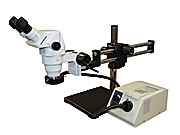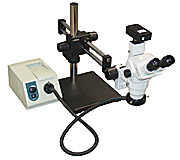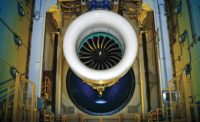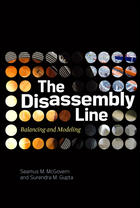
A typical stereo zoom microscope features a 10X eyepiece, 6.7:1 zoom ratio, and a 100-millimeter working distance. This combination provides a range of magnification from 6.7X up to 45X. The eyepieces and auxiliary lens may be changed to vary the magnification and field of view. Source: Scienscope International
This has become a society demanding immediate gratification in virtually all aspects of life, particularly when there are problems to solve. In the work environment or in private lives it is the same-solve the problem quickly, efficiently and move on. Manufacturing is no different.
Manufacturing has relied on basic microscopes to identify problems as the first step to a solution. A basic binocular stereo zoom microscope has long been the workhorse for primary, first-article inspection across the broad spectrum of manufactured goods.
Finding a crack or hairline fracture for example, in a small cast part would be impossible without the magnification and 3-D image of a binocular microscope. The 3-D image can help the inspector to determine if a hairline fracture penetrates the wall of the casting or is in fact just a scratch on the surface and poses no problems. Inspectors of printed circuit boards constantly examine solder joints for a nice smooth flow around each joint. Poor flow or no solder at all is easily noticed with a stereo microscope. From textiles to electronics, plastic injection molded parts to razor blades, all inspectors rely on the crisp, clear 3-D image from the microscope to examine the results of production.
After a problem area is identified, the next step in the solution process is to share the information so corrective action can be taken. For example, plastic injection molded parts are inspected immediately after a line starts up to find excessive flash or poorly formed small details of the part before thousands of bad parts can be produced. The nature of the flaw can sometimes determine what corrective action is required.
The inspector and the molding operation could be in Michigan, the customer and designer of the mold could be in California and perhaps the mold was made offshore. In this instance, the ability to send images of the parts immediately to decision makers saves time and money. A binocular microscope is a tool for individual use but communicating to an engineering group or supplier exactly what an inspector sees is difficult. How can all parties in different locations look at the same image and the same area of concern?

The third port variation of a standard binocular microscope accepts a video coupler, or video adapter, with a variety of magnification choices. An industrial live image digital video camera is added to the coupler so the same image viewed through the eyepieces can now be viewed on a computer monitor. High-resolution digital cameras of 1.3 mega pixels are readily available with a USB2 interface to transmit high-quality real-time images. Systems can be configured with a variety of stands and lighting sources for specific applications. Source: Scienscope International
Move to trinocular microscopes
Manufacturers are quickly adding specially equipped trinocular microscopes to their inspection areas. The systems are configured with high-resolution industrial digital cameras that link directly to a PC for easy image capture and immediate communication with all interested parties. Furthermore, software allows the inspector to draw arrows and make notes relevant to the area of concern and e-mail it.Simple technology allows everyone concerned to instantly view and discuss the same information. Better yet, a live video image of the part in question might be available. Software allows multiple locations to view the same live image at the same time from a host site anywhere in the world. Each remote site has the ability to take over the curser and point out its own area of concern in real time, getting everyone on the same page or screen.
The ability to easily capture images and communicate immediately has led to the remarkable popularity of trinocular video microscopes. Computers today have vast memory capacity so manufacturers can easily archive images of sensitive details or peculiar aspects of production runs.
In large factories, production can immediately inform engineering of first-article production results, saving valuable time frequently lost because of inefficient communication. Some operators have experienced savings in training time by implementing a trinocular microscope to capture vivid specific images of critical pass/fail aspects of their products.
So many companies have international operations with design, parts production and final assembly in different countries throughout the world. A simple trinocular digital imaging system in each location puts each operation on the same page at nearly the same time.

